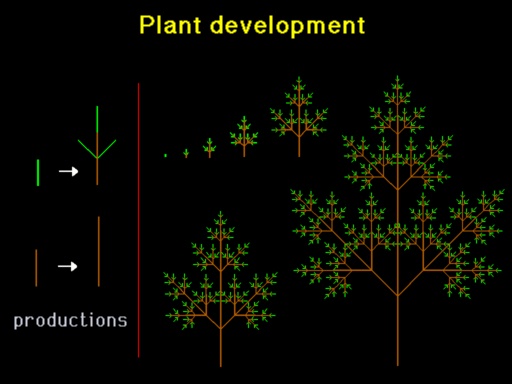In the domain of plants, the models discussed up to this
point have two limitations. First, they are extremely opportunistic: the
growth of a structure is controlled almost exclusively by the environment.
In reality, plant structures are determined to a large extent by genetic
factors. In addition, all models described so far represent accretive growth;
that is, a process in which a structure develops by the progressive addition
of new material. The developmental patterns of higher organisms are often
much more complicated.
For example, during the development of the compound leaf shown
in
Animation 5,
the apex produces a succession of leaflets that grow in size while the internodes
elongate and the branching angles increase. The changes of the branching
angles and the elongation of the internodes are non-accretive components
of this process.
Similar phenomena can be observed in the development of
shoots of Fraxinus pennsylvanica, or green ash [Pru1994b].
Animation 6 illustrates
this development from a fixed viewpoint, while
Animation 7
shows the
same simulation from the viewpoint of a camera focused on the shoot apex.
Note the gradual elongation of internodes and changes in
branching angles. An additional view of shoot emergence from the bud is
presented in
Animation 8.
To capture such non-accretive, internally
driven processes, Lindenmayer [Lin1968]
proposed a model of development based on rewriting rules or productions.
This model, known as L-systems, originally provided a formal description
of the development of simple multicellular organisms and was later extended
to higher plants. The rewriting rules operate on entire modules of a plant;
for example an apex, an internode, or a leaf. Each rule consists of two
components, a predecessor and a successor, as illustrated in
Plate 12.

During a derivation step, the predecessor
(identified by its label) is replaced by the successor. Lindenmayer developed
a string notation that makes it easy to specify productions and carry out
simulations. Even very simple L-systems can produce plant-like structures.
For example,
Plate 13
presents an L-system with two productions.

The first production specifies that the apex, shown in
green, creates a branching substructure with three apices and an internode.
The second production increases the internode length. Productions are assumed
to be invariant with respect to scaling, which means that if we change the
length of the predecessor by factor r, we should rescale the
successor by the same factor. The developmental process starts with an apex
and yields a compound leaf structure, resembling those found in some fern
fronds. |